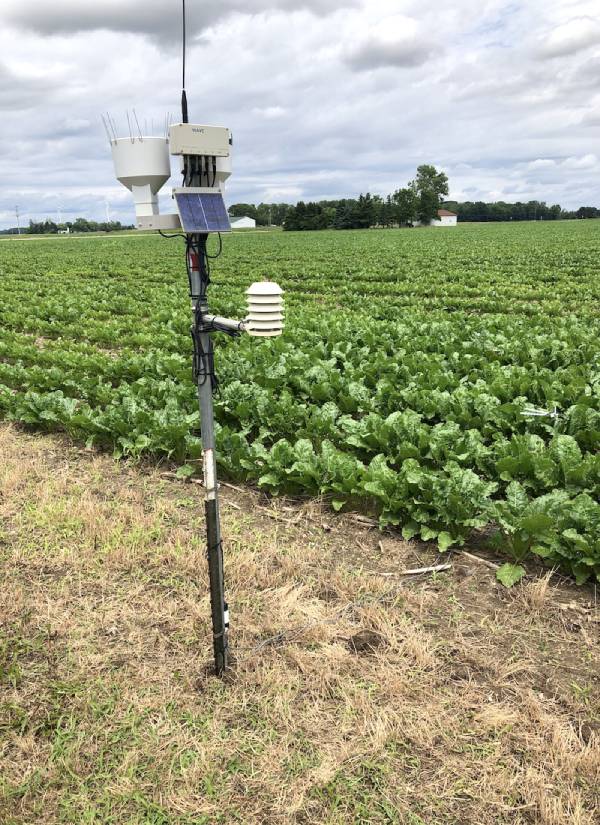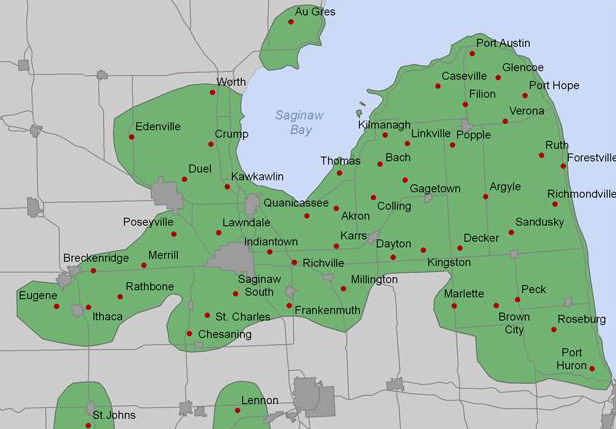Sugar beets without Cercospora
Summary
To help sugarbeet growers in Michigan and southern Ontario, Weather INnovations in partnership with Michigan Sugar developed a network of 68 ADCON telemetry weather stations throughout the two regions to monitor sugarbeet fields. Each weather station is equipped to monitor temperature, relative humidity, rainfall, and leaf wetness with the option for soil moisture and soil temperature monitoring. This project started in 2004 and continues to operate today. The data from these stations feeds the information to WIN’s BEETcast™ model, a weather-based modeling program designed to help sugarbeet growers determine optimum fungicide application timing for the control of Cercospora leafspot. Growers use BEETcast™ to monitor Disease Severity Values (DSV’s) that determine how high of a risk their fields are for Cercospora. DSV’s are driven by hourly average temperature and the number of leaf wetness hours. In order to determine when spraying is required, these DSV values accumulate until a threshold is reached, where spray application is recommended. This system allows growers to tailor their program to their sugarbeet variety susceptibility and the level of risk management they are comfortable with.
Challenge
Cercospora is a fungal disease that attacks the plant foliage, causing small dead areas of spots eventually turning the whole leaf black. It is among the most serious diseases of sugarbeets in Michigan and Ontario, capable of inflicting significant tonnage and sucrose losses as well as increased impurities. Cercospora favours wet, warm and humid conditions and flourishes after canopy closure. Once the field is infected the disease goes dormant during unfavourable conditions and reemerges once the temperatures rise and rain returns. Research shows that early defoliation by disease will significantly reduce tonnage and sugar content up to 2%. To minimize the risk of Cercospora, spray application timing is critical for growers.

Solution

In 2004, Dr. Ron Pitblado, of Ridgetown College and Weather INnovations Consulting LP, developed an advisory system to indicate the most suitable intervals for fungicide application. This advisory takes into account specific weather conditions, such as temperature and leaf wetness. Researchers from the Michigan Sugar Company, along with pathologists from Michigan State University, conducted trials to determine these initial optimum times. The ADCON telemetry units were placed strategically across the sugarbeet growing regions to monitor 3 risk areas, low, medium and high. The stations are installed in sugarbeet fields at planting time and remain there until it is time to harvest. The real-time weather data, along with 10-14 day forecasts drive the BEETcast™ disease advisory model.
Results
Due to the spatial distribution of the ADCON telemetry paired with WIN’s BEETcast™ model, growers have been able to reduce crop losses due to Cercospora by making informed and timely spray decisions. Along with BEETcast™, WIN has developed and included additional tools for growers which are accessible on michiganbeets.com including SPRAYcast®; Growing Degree Day based growth stage models, alerts and site specific field mapping.
Sustainable Success
The current project has been in place since 2004 collecting years of valuable information used in research and analysis by Michigan Sugar. The success of the Michigan Sugar network has branched off into smaller customized projects such as beet pile monitoring, using soil temperature probes installed in beet piles to monitoring hot spots ensuring quality through the winter months. The Michigan Sugar weather network has also played a role in capturing Cercospora spores in order to pinpoint infection periods more precisely.
The density and longevity of the network has allowed for more research into disease growth and susceptibility in sugarbeets. With extreme variability in temperature and rainfall, weather monitoring and decision support tools play an important role in growers’ on-farm decisions.
